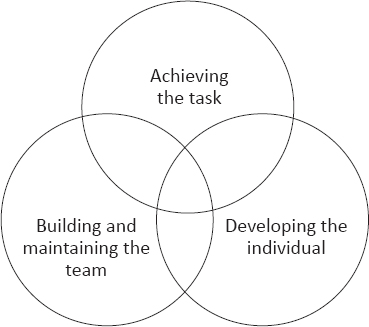PART ONE
Understanding Leadership
My greatest discovery by far has been regarding what people now call the generic role of leader, the role that is common to all working groups and organizations anywhere in the world.
At the heart of that role lie the three overlapping core responsibilities of any leader: achieving the task, building and maintaining the team, and developing the individual.
This model implies an understanding of the environment in which you are working. In order to fulfil these responsibilities, you need to know your business, and you need to possess or develop the necessary qualities of personality, character and skills to provide the eight generic leadership functions: defining the task, planning, briefing, controlling, evaluating, supporting, motivating, and setting an example.
The three circles of leadership functions integrate together what we customarily call leadership and management, but these concepts do retain their own distinct overtones:
- Leading is about giving direction, especially in times of change; inspiring or motivating people to work willingly; building and maintaining teamwork; and providing an example, producing a personal output – or doing some of the work yourself.
- Managing is about running the business in ‘steady-state’ conditions; day-to-day administration; organizing structures and establishing systems; and controlling, especially by financial methods.
Both sets of skills and activities are essential. You have to be a manager-leader or a leader-manager, depending on your specific role and/or your level of responsibility in the organization.
‘Management is prose, leadership is poetry.’

